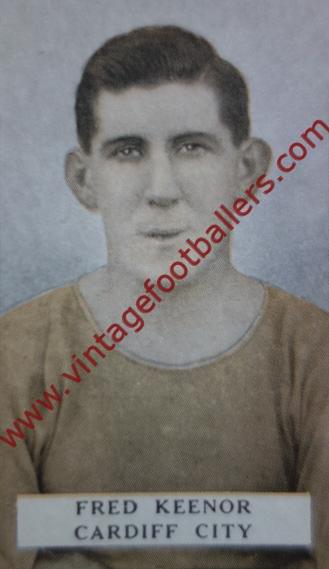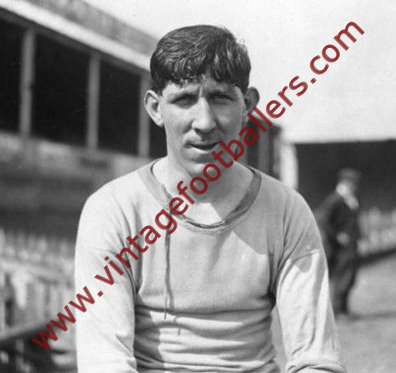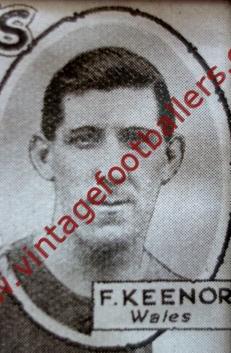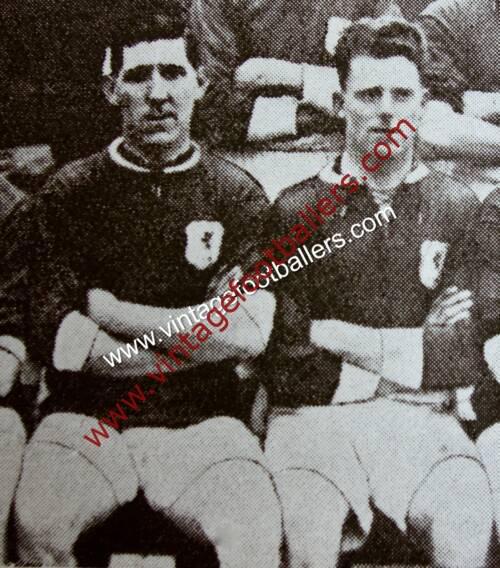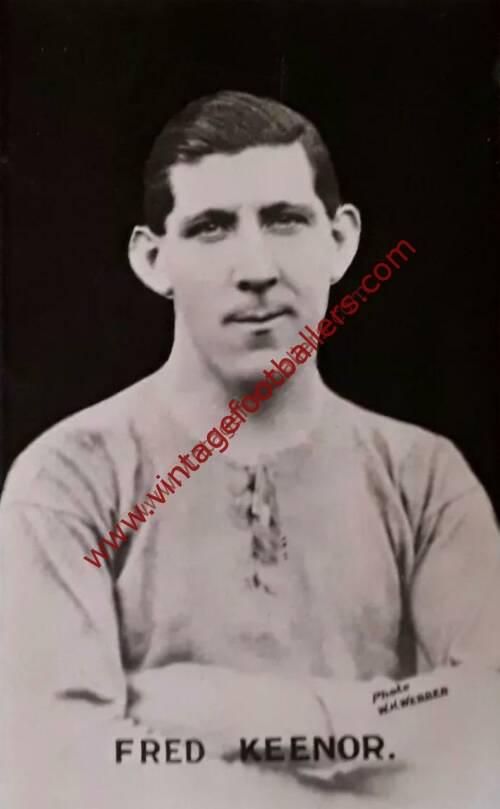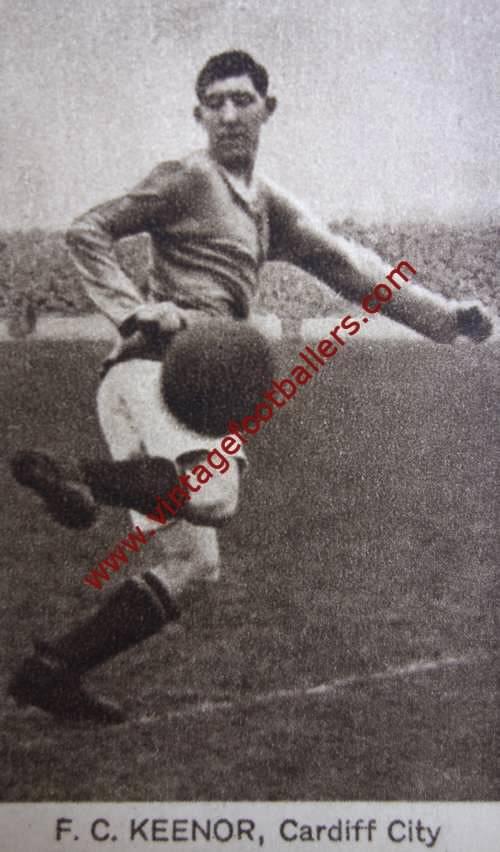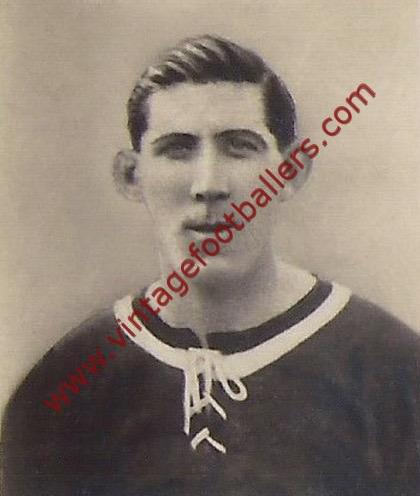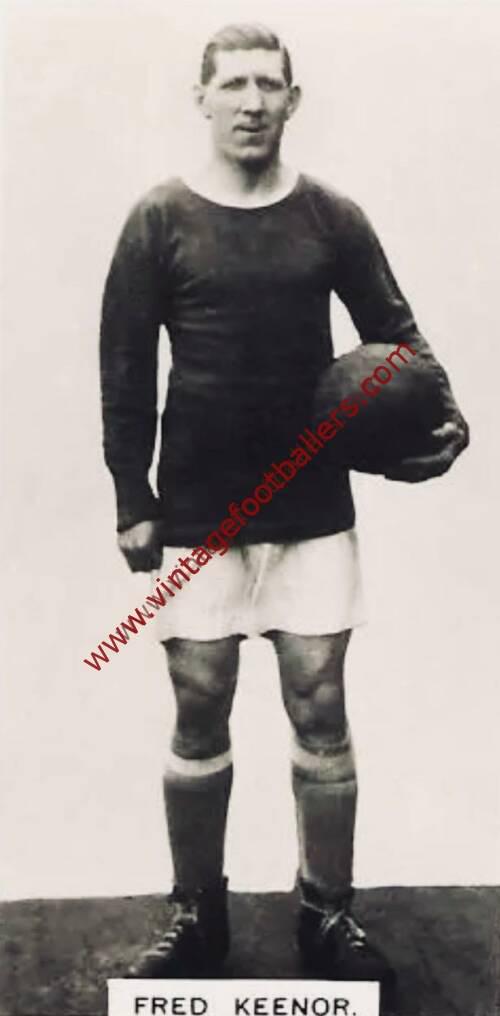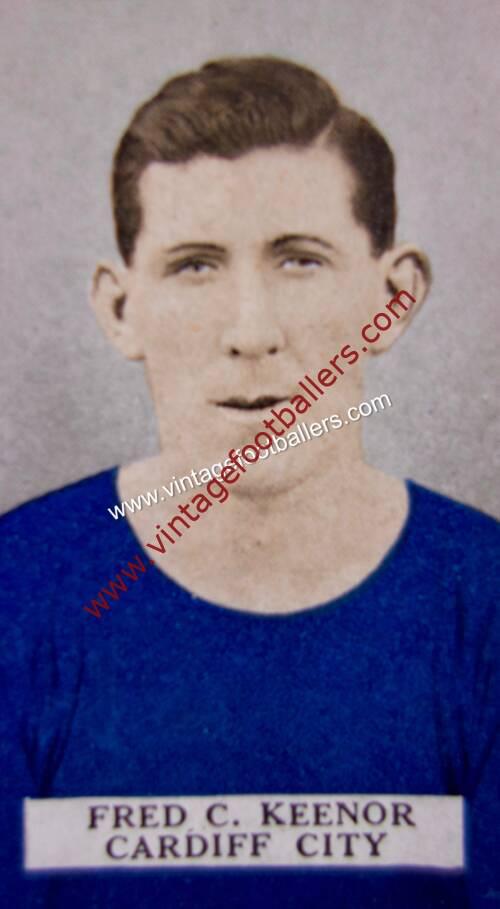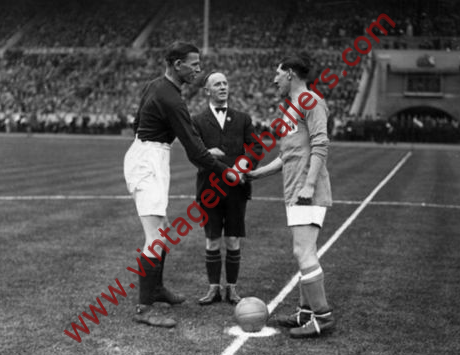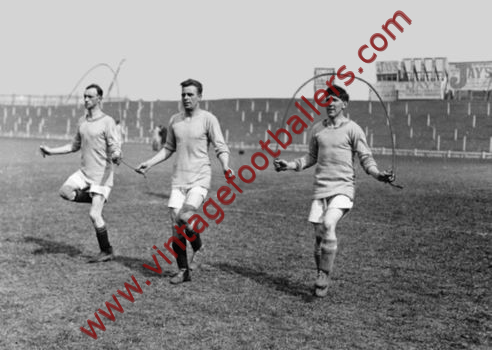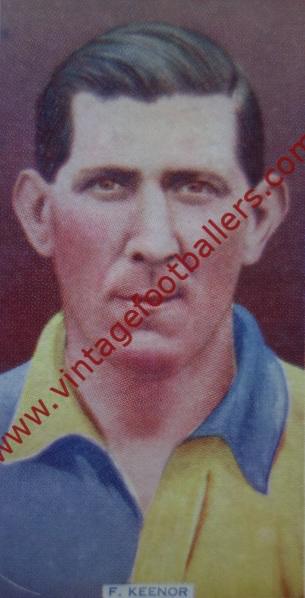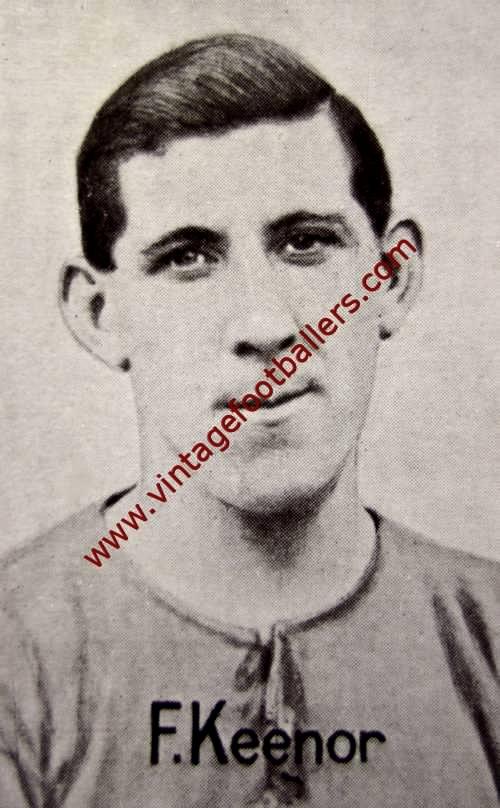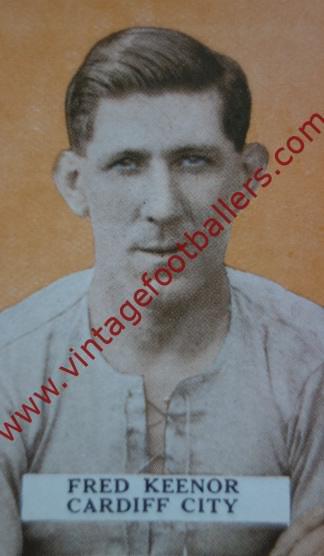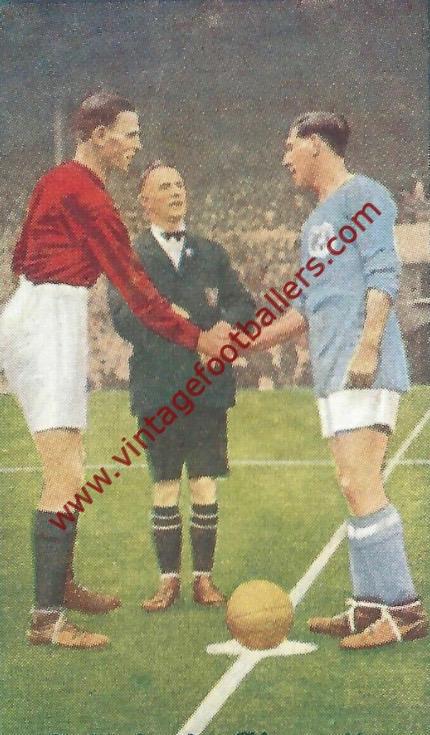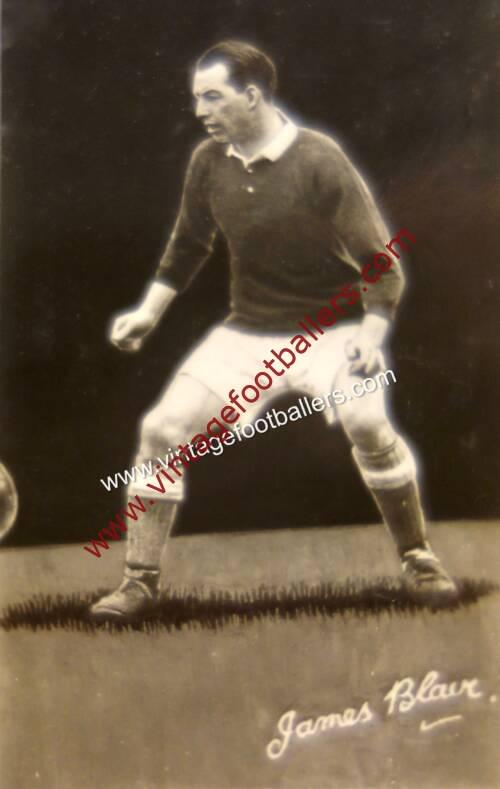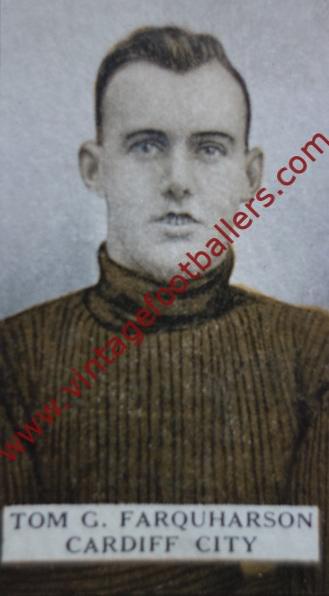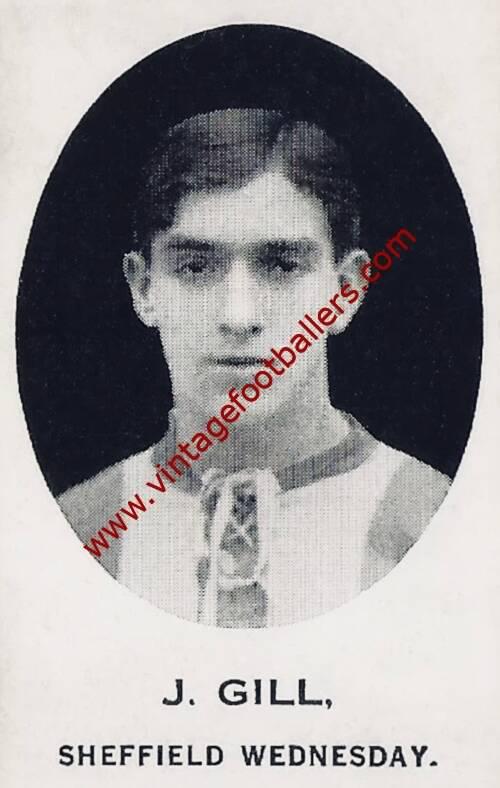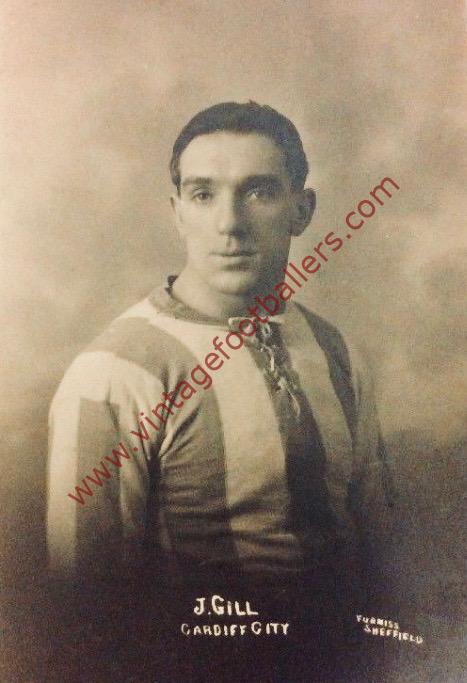Description
Cardiff born centre half Fred Keenor was an outstanding Welsh footballer, second in influence to the development of Welsh football possibly only to Billy Meredith in the pre Second World War era. Having played for Cardiff Schoolboys, Keenor was selected to represent the Welsh schoolboy side in 1907 and appeared as an outside right in the first ever meeting between the English and Welsh schoolboy sides. He began his adult football career with local junior side Roath Wednesday, the team of the district of Cardiff in which he grew up, before joining hometown Southern League club Cardiff City in May 1913, initially on an amateur contract aged 17.
His whole-hearted performances for the amateur side persuaded the club to offer Keenor his first professional contract. The Cardiff squad was undergoing a significant overhaul under the management team of secretary-manager Fred Stewart and trainer George Latham; all but four of the senior team players they had inherited from previous manager Davy McDougall were released. The pair were impressed by Keenor’s performances and handed him first-team opportunities at the end of the 1912-13 season. Keenor featured in two friendly matches, a 9-0 victory over Bridgend YMCA, in which he scored, and a 1-1 draw with Mid Rhondda. However, the presence of Billy Hardy, Patrick Cassidy and Kidder Harvey, who became known as the “Holy Three” by fans, restricted his first-team opportunities as the trio ensured the club won promotion to the First Division of the Southern Football League after conceding just 15 goals during the campaign. Keenor was forced to wait until 6th December 1913 to make his competitive debut for the club, playing in a 1-1 draw with Exeter City in the First Division. However, he endured a difficult start and was described in a local newspaper report as “the weak link in a very strong side”. He made just two further appearances for the side during the remainder of the 1913-14 season.
The following season, Keenor became much more involved in the first team at Ninian Park. After missing the opening game of the season, a defeat to Watford, he featured in five consecutive matches to replace an injured Cassidy. His performance during a victory over Brighton & Hove Albion earned glowing reviews in the Athletic News which reported “One can safely predict a brilliant future for him, providing of course, he is well looked after. On Saturday, he was a menace both to the Brighton attack and defence. One minute he would be tackling a Brighton forward, the next he would be leading Cardiff forwards. He is a sound tackler, places perfectly, is a hard worker and can be of great assistance to his forwards both in feeding them and taking part in combined movements.”
Cassidy’s return from injury saw Keenor drop out of the side. He didn’t appear for the first team from October 1914 until a match on 2nd January 1915. Following this, he featured in 15 of The Bluebirds’ next 18 matches.
During the season, Cardiff came under pressure from local newspapers, most notably the Western Mail, for the club’s perceived lack of contributions to the war effort. The Western Mail printed numerous scathing comments focused on association football clubs and even refused to report on Cardiff’s matches for a time. The club later countered the paper’s actions by accusing it of chasing “cheap popularity”. Keenor, himself a patriot, was torn between the two, having finally established himself in the first team after three years at Ninian Park.
He eventually enlisted in February 1915, along with teammate Jack Stephenson, trainer George Latham, who had previous military experience having served in the Second Boer War, and two of the club’s directors. He joined the 17th Middlesex Battalion, which became known as the Football Battalion due to the many footballers who made up the core of the unit. Led by former England international Frank Buckley, the regiment had been founded by William Joynson-Hicks, 1st Viscount Brentford, in December 1914 in the hope of attracting footballers and fans into enlisting in the Armed Forces.
Stationed in London with the Regiment, an arrangement was made allowing players to return to their clubs for League matches to fulfill their contractual obligations. Keenor travelled by train every weekend to the venue of each Cardiff fixture to keep playing and was listed in the matchday programmes as “Private Keenor” for the remainder of the season. Cardiff finished the season in third place in the First Division. Keenor made 21 appearances in the League during the season, scoring two goals.
The effects of the war effort crippled the club’s finances. With travel restrictions placed on train services, and local men enlisting en masse, Cardiff’s income from attendances dwindled. The situation became so dire that players were told to look for part-time jobs during the summer break in case the club was unable to pay their wages. When they threatened to strike, the club’s committee approached Keenor over the possibility of forming a squad from his fellow soldiers of the Football Battalion. However, with the War escalating, the Football Association officially suspended all of its competitions at the end of the 1914-15 season, negating any need for Keenor to raise a team.
Keenor and his battalion were moved to the country residence of the regiment’s founder, William Joynson-Hicks, near Dorking, where they began basic training. Keenor was a notoriously poor shot with a rifle, even being described by the regimental sergeant major as “the worst shot he had ever seen”. During their posting, the battalion organised a fixture against Cardiff City on 2nd October 1915. Keenor was originally due to play for the army side against his club, but Cardiff manager Fred Stewart asked that he play for his club side. The match ended in a 1-0 victory for the battalion.
One month after the match, on 16th November, Keenor and his battalion began the journey to France to join the front lines. They billeted in the village of Les Ciseaux for one month before moving to the city of Béthune. Most of his posting during his battalion’s first months in France involved training and guard duty. On 9th December 1915, however, they were posted to Annequin near the front line. They were soon moved into the main trenches, which were knee-deep in mud and infested with rats. His battalion remained on duty until 22nd December when they were relieved, resting in the nearby village of Beuvry over Christmas.
Cardiff City organised regular collections at their wartime fixtures during this period to send parcels to Keenor and Jack Stephenson containing letters from fans and home comforts. The Middlesex Battalion claimed the Divisional Football Cup with relative ease, defeating a team from the 34th Brigade 11-0 in the final on 11th April 1916; each player received a winners’ medal made of bronze.
However, the War soon took its toll on the battalion as they began suffering casualties from the fighting, including Buckley who suffered severe shrapnel injuries. Having returned to the front, the Regiment was involved in the Battle of the Somme, one of the bloodiest battles in history, in particularly the Battle of Delville Wood. Keenor later described the scene during what he called a “hellish battle”, stating:
“One must pay tribute to the good work of the Footballers’ Battalion. Stationed at Delville Wood, Jerry’s artillery threw everything he has at us – and then some. It simply rained shells. The wonder was that any of us came out alive. It was attack and counter-attack day and night, but during the battle for possession of this wood there was not a sign of cowardice among our men. Some of them may have been called “windy” on the football fields of England, but out there in France they stood the real test of all.”
During the battle, Keenor was badly wounded when a piece of artillery shrapnel struck his left leg above the knee on 28 July, leaving him unable to walk. An unknown soldier saw him attempting to crawl away from the incoming fire and managed to help him back to the nearby medical facilities where army doctors were able to tend to his injury. The wound was so severe that they considered amputating the leg but decided against it. He was removed from the Western Front and transported to an army hospital in Dublin where he spent six months undergoing rehabilitation on his injured leg.
Following his return to service, Keenor was stationed in Chatham, Kent, as a physical training instructor for the 5th Reserve Brigade. He was later promoted to the rank of Sergeant and was awarded the Victory Medal, the 1914-15 Star and the British War Medal for his service during the War. Between 1915 and 1919, Keenor appeared as a guest for Brentford in the London Combination. During the 1918-19 season, the side won the League title with Keenor making 19 guest appearances. Keenor first appeared for his country when he featured for Wales in two unofficial Victory internationals in 1919.
When the Football Association resumed fixtures in 1919 following the end of hostilities, he re-joined Cardiff City, despite being told by army doctors that his shrapnel wound meant he would never play football again. He resumed playing in the Southern Football League for the club, playing his first competitive match in August 1919. Having mostly been a member of the reserve team before the outbreak of the War, Keenor returned to Cardiff as an experienced member of the squad having played for his battalion and Brentford during wartime. He featured in two of the club’s three pre-season fixtures. Fred Stewart resumed his role of secretary-manager following the war. He was given a selection issue in the form of Keenor and the presence of his regular first choice Patrick Cassidy. However, Cassidy pushed for Keenor to be given the chance to play due to his “youth and promise”. After this, Keenor featured regularly for the first team. Cardiff’s squad had escaped the War relatively intact with most of the side returning to play. They went on to win the 1920 Welsh Cup, defeating Wrexham 2-1 in the Final, the first of Keenor’s four Welsh Cup victories. They finished fourth in their final season in the Southern League, and were admitted into the Football League Second Division in 1920.
Keenor won his first international cap for Wales when he played against England in a 2-1 Welsh victory at Highbury in March 1920. On 16th February 1924, Keenor was handed the Wales captaincy for the first time in his career for a match against Scotland. The Scots were captained by his Cardiff teammate Jimmy Blair, making the match the first time in the history of international football that opposition teams had been captained by players from the same club side. Keenor’s senior international career coincided with a period of success for the Welsh national side and he won a total of 32 caps. They won the British Home Championship in 1920, 1924 and 1928, overcoming an increasing reluctance on the part of English clubs to release players for games they saw as being of no importance. In a match against Scotland at Ibrox in October 1928, with Wales unable to call up a replacement, Keenor had to play with strapping to protect his injured neck and was advised by a doctor to avoid heading the ball during the game. Despite stating that he was “in agony throughout”, Keenor played the full 90 minutes of a 4-2 defeat.
By the time Cardiff entered the Football League, Keenor had established himself in the first team. As a result, Cardiff allowed two of the “Holy Three”, Cassidy and Harvey, to leave the club. Keenor appeared for the side in their inaugural Football League fixture, scoring in a 5-2 victory over Stockport County. In their first season, Cardiff finished second to Birmingham City, missing out on winning the Championship because of goal average after finishing level on points. Cardiff won promotion to the top tier of English football and also reached the 1921 FA Cup semi final, losing to fellow Second Division side Wolverhampton Wanderers in a replay. Keenor scored his side’s only goal in a 3-1 defeat at Old Trafford. He later revealed that he had been approached by an unknown person before the game who offered him a bribe to throw the match but had flatly refused to consider the idea.
After a difficult start in the First Division, losing the first six matches of the season, Cardiff secured their first victory in the top flight by beating Middlesbrough 3-1 on 24th September 1921. Keenor had been switched to centre half for the match, a move Fred Stewart had resisted for some time because of his concern over Kennor’s lack of height. Away from his usual position at right half his performances impressed so much that he would go on to play the position for the remainder of his career. The 1921-22 season was also Keenor’s tenth year at Ninian Park, and he was subsequently awarded a testimonial match against Bristol City.
In the following five years, Cardiff became an established side in the First Division, missing out on the League title in the 1923-24 season to Huddersfield Town on goal average after drawing the final game of the season when a win would have guaranteed them the title, which is still Cardiff City’s highest League position.
Soon after, in May 1924, the club embarked on its first ever European tour, beginning with an ill-tempered match against Czechoslovakian side Sparta Prague. The match was an intensely physical encounter with Cardiff accusing their opposition of dirty tactics. As the teams left the pitch at the end of the first half, a furious Keenor, upset at the nature of some tackles he had received, yelled at the Prague players, “If I get anymore kicks on the shin I shall be chopping someone off at the knee”.
In the second-half, Cardiff players found themselves being physically assaulted by members of the crowd, who aimed kicks and punches at the players, when they approached the sidelines to take throw-ins and corner kicks. Cardiff went on to lose the match 3-2. They later played matches against First Vienna in Austria and Borussia Dortmund and Hamburger SV in Germany.
The following season, Cardiff reached the 1925 FA Cup Final where they lost 1-0 to Sheffield United, who claimed their fifth FA Cup win following a goal from Fred Tunstall. After the Final, Keenor stated: “Just because we lost in our very first Cup Final, I don’t think there is any cause to get down in the mouth. I can say here and now that one day soon our followers can be sure that Cardiff City will bring that Cup to Wales”.
At the start of the 1926-27 season, the departure of club captain Jimmy Blair saw Keenor appointed the new permanent captain of The Bluebirds. He led the team to a second FA Cup final in 1927. However, Keenor came close to not playing in the match as, having struggled to hold down a first team place due to injury, he handed in a transfer request in January 1927. His request was approved by board members Walter Riden and Syd Nicholls and negotiations over a proposed move to Severnside rivals Bristol Rovers were opened. The move later collapsed, with Rovers’ offer being deemed unsatisfactory. Instead, Keenor returned to the starting eleven that defeated Arsenal 1-0 with a goal from Hughie Ferguson. He was praised for his leadership of the team’s defence during the match and earned plaudits from opposing captain Charlie Buchan. By winning the trophy, Cardiff had become the first and to date only team outside England to win the FA Cup and Keenor, as captain, was handed the trophy by King George V.
Following the match, Keenor and the rest of the team travelled to the Palace Hotel in Bloomsbury, which hosted a celebratory dinner for the players and their wives. The next day, they returned to Cardiff, with around 150,000 people lining the streets of the city to see the team arrive. After a parade through the streets of the city, they were taken to City Hall where they were presented to the crowd by the Lord Mayor. Keenor was overawed by the adulation of the crowd, stating: “The Cup was worth winning if only to get a reception like this”. One newspaper published a caricature the following day, describing him as “the most important man in Wales” with an image depicting Keenor knocking former Prime Minister David Lloyd George off a pedestal. Keenor also captained the side to victory in the Welsh Cup, defeating Rhyl 2-0 in the Final, and in their 2-1 victory over amateur side Corinthians in the FA Charity Shield at Stamford Bridge in October 1927.
Cardiff City entered a period of decline in the following years. Two seasons after their Cup triumph and despite conceding the fewest goals in the division, Cardiff were relegated to the Second Division at the end of the 1928-29 season. An ageing Keenor became a target of frustrated fans as Cardiff suffered financial difficulties that saw the majority of the team’s star names sold in a bid to raise funds. Replacements were signed from amateur sides, but the team struggled in the Second Division. Before the 1930-31 season Keenor was still on the wages he had received when the club was in the First Division. They gave him a twenty-five per cent pay cut during the season and a fifty per cent cut during the off-season. Club director Walter Bartley Wilson, who had intended to leave Keenor with no choice but to leave the club due to the severe drop in wages, instigated the cuts. However, Keenor told him, “Bart, I’m going to surprise you too. I’m going to take it”.
Despite this, he was eventually dropped from the team as they struggled for form and the club signed Jack Galbraith from Clapton Orient as a replacement.The side’s form showed little improvement. Keenor played his final match for the club on 6th April 1931 against Tottenham Hotspur, along with the club’s all-time record goalscorer Len Davies. They finished the season in 22nd position and were relegated to the Third Division South. Keenor was released at the end of the season, ending a 19 year spell with the side, having scored 17 goals in 432 appearances for Cardiff City.
In October 1930 a heavily depleted Welsh side who were unable to call up many of their star players for a fixture at Ibrox Park, Glasgow against Scotland as Football League clubs refused to release them for international duty, a fixture that became known as ‘Keenor and the 10 Unknowns’. Manager Ted Robbin’s side, playing on a Saturday when the English Leagues had a full programme, had no choice but to play 10 players from either the lower divisions, Welsh League sides, or from the non leagues. The Welsh featured just seven players from Football League sides, with only Keenor and Cardiff teammates Len Evans and Walter Robbins playing in the top two divisions. The rest of the side contained three players from Welsh league sides Cardiff Corinthians, Llanelli and Colwyn Bay and one player from non league side Oswestry Town. The side featured nine debutants in the line-up, with Keenor and Cardiff teammate Len Evans being the only two with previous experience at international level. Wales had been forced into a similar situation eight months earlier, in February 1930, when Keenor had played in a severely weakened side that lost 7-0 to Ireland, Joe Bambrick famously scoring six of Ireland’s seven goals in the game. Keenor described the match as the worst game he had ever played.
Before the match, Keenor had asked Robbins if he could have the players to himself for four hours before the game. Taking the team to relax and discuss tactics for the match, in his pre-match team talk he exhorted his teammates, “There’s eleven of them and eleven of us, and there’s only one ball, and it’s ours”. Despite their inexperience, the Welsh side held Scotland to a 1-1 draw having taken the lead after six minutes through a Tommy Bamford goal. The display led the Welsh public to call for the same side to remain for the following match against England. There was no repeat of the result, however, the Welsh side lost 4-0 at The Racecourse Ground. Keenor won his 32nd and final cap for Wales on 26th October 1932 in a 5-2 victory over Scotland at Tynecastle. He scored twice during his Welsh international career.
Following his release from Cardiff City, he considered retiring from the game but eventually signed for Third Division North side Crewe Alexandra. Despite being 37 years old, Keenor played a pivotal part in the club’s sixth placed finish during the 1931-32 season. This was the joint highest finish that the club had ever achieved in the Football League, and only the second time they had finished in the top ten in the previous nine seasons. However, despite a strong season, he was disappointed that the club was unable to achieve promotion as he described the squad as having the “nucleus of a very good side”. They recorded several strong results, including defeating eventual Division Three (North) champions Lincoln City 8-0.
Crewe later lost the return fixture against Lincoln 5-0. They conceded all five goals during an hour long spell when Keenor had left the pitch after being knocked unconscious earlier in the match when attempting to block a shot. Although his advancing years had lessened his abilities, Keenor became a huge draw for Crewe, and if he was unable to play due to injury, the club would withhold the information before the match in fear of affecting attendance figures. He spent three years at Gresty Road, and it was while at Crewe that he won his final cap for Wales. At the age of 41, Keenor left the professional game in the summer of 1934, moving into non-league football as player-manager of Oswestry Town and then in 1935 of Tunbridge Wells Rangers, eventually retiring from the game in February 1937.
Keenor was renowned for his fitness levels, despite being a heavy drinker and smoker. Former teammate, Ernie Curtis said of him: “He was one of the hardest tacklers in the game, some said he was dirty but he was just hard. Nobody took liberties with old Fred … [He] could run all night, he couldn’t run with the ball mind you, but he could run all day”. Charlie Buchan, captain of the opposing Arsenal side in the 1927 FA Cup Final, described Keenor as having “a store of energy (that) seemed inexhaustible in defending his goal”. His hard-tackling style made him a target for opposition fans; he was once assaulted following a match for Crewe Alexandra during the later years of his career after a physical performance against an opposition side angered some of their fans.
He was also famed for his leadership qualities. He was renowned at Cardiff City for being a vocal player on the pitch well before his appointment as Club Captain in the mid-1920’s, often barracking considerably more experienced players. In his biography of Keenor, James Leighton stated “he ran tirelessly for the cause and would frequently put his body on the line … His endeavours could only inspire his teammates to reach a higher standard of play”.
Keenor is considered to be one of Cardiff City’s all time great players and was inducted into the Welsh Sports Hall of Fame. On 15th November 2007, a petition to the Cardiff Civic Authorities was begun to bestow a tribute upon both Keenor, and the 1927 FA Cup squad he captained. On 4th December 2009, the road approaching Cardiff City Stadium was named Fred Keenor Road.
In 2010, a fundraising campaign was started by the Cardiff City Supporters’ Trust to raise funds for a statue of Keenor to be placed outside the club’s stadium. The statue cost £85,000, which was raised through public donations and donations from the Welsh government and the Football Association of Wales. It was designed by artist Roger Andrews, who had previously designed a statue of Tasker Watkins that was erected outside the Millennium Stadium in Cardiff. On 10th November 2012, the statue of Keenor holding the FA Cup was revealed outside Gate 3 of the Cardiff City Stadium.

